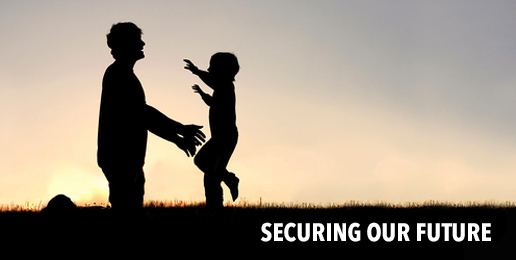
Our ability to protect children from sexual exploitation is declining every day. The environment has become sexually saturated. Prime-time programs on broadcast television promote casual sex, even for teens. Pornography is impossible to avoid short of disconnecting all electronics.
Standards of dress and conduct have become eroticized. Societal taboos about sexual experimentation have severely eroded, and internal inhibitions have steeply declined.
In our primary and secondary schools, an all-out war over values is being waged, largely unseen by the broader public. On the one side are those who promote the traditional values of purity, innocence, and sexual abstinence until marriage. On the other are the so-called sex-positive proponents who claim to promote the sexual rights of children.
Children, they say, have the right to enjoy sexual pleasure whenever and with whomever they want as long as there is consent, despite the fact that children cannot legally give consent. Not only that, these same activists encourage children to experiment with a variety of sexual activities—same and opposite sex—to fully explore their sexuality.
The sex-positive crowd is winning over a majority of the school districts primarily because the principal advocates of that philosophy (SIECUS, Answer, Advocates for Youth) were the driving voice in creating the National Sexuality Education Standards. Consequently, comprehensive sexuality programs that incorporate sex-positive messages are being rapidly adopted in schools throughout the country.
All this makes children, especially the more emotionally fragile children, much more vulnerable to the growing numbers of slick predators who seek out their victims by becoming involved with child-serving organizations. Additionally, growing numbers of these predators are children and teens themselves.
Churches, youth services organizations and other groups that serve minors attempt to provide a positive and safe environment for children and adolescents within this hostile cultural climate. These organizations provide a rich hunting ground for child sexual predators.
Unfortunately, child protection programs for virtually all organizations that serve children fail to screen out more than 98% of child sexual predators who seek child and youth serving positions. It doesn’t make any difference whether the organization is a public school, a private school, a church, a sports club, the Boy Scouts or the Girl Scouts.
The reason is simple. These organizations rely, almost exclusively, on background investigations that concentrate on criminal background checks, and checks of the national and state sex offender registries to determine if the applicants are “safe.” As I detail below these checks are wholly inadequate in identifying child sexual predators.
Even those groups that check references, verify past addresses, interview previous bosses, examine civil court cases, conduct extensive interviews of the applicant, etc., miss the mark by a wide margin, mostly because they don’t really know what to look for.
Most Child Sexual Predators are Never Caught
The problem with the criminally focused background investigations is that very few child sexual predators are ever caught. Thus, they don’t show up in a check of their criminal records or the sex offender registries. According to a study conducted by Dr. David Finkelhor and Jennifer Dziuba-Leatherman, only three percent of child victims ever report their abuse to the police. Only about half of these are ever convicted.
In a recent study by Wendy Walsh, et al information was obtained from the Dallas Child Advocacy Center regarding cases of child sexual abuse that were handled by that agency. Of the 360 cases that were investigated, just 64% were accepted for prosecution, and of those there was an 80% conviction rate.
The Dallas Center has resources and capabilities that exceed those of most other jurisdictions in the country, so their results in handling these cases can be considered the best possible. Outcomes in other jurisdictions usually aren’t as favorable. Even so, if we extrapolated the results in Dallas to the whole country, simple math demonstrates that only 1.6% of cases lead to conviction (64% of 3% is roughly 2%, and 80% of 2% is 1.6%).
But it’s even worse than this. Many cases that eventually are reported to the police are not even investigated because the statute of limitations has lapsed. And some of the cases that are prosecuted result in plea bargains that reduce the charges to misdemeanors or non sex related offenses. The bottom line is that a tiny fraction of active child sexual predators will ever show up in record checks, thus, using checks to screen them out–while still important–are largely ineffective.
We need to start doing something different.
A Transient Population
Until a hundred years ago or so, most of us were born, raised, lived, and died, all within a short radius—a few miles, maybe. We knew everyone in our small town or tightly-knit urban neighborhood. And everyone knew us. Not only us. They knew our parents, our brothers and sisters, our grandparents and Aunts and Uncles. They watched us grow up. They saw how we handled adversity or prosperity. They saw us under stress, in competitive situations and during life changing threats and losses. They knew us so well they could predict how we would act or react in a variety of situations.
If you entered the military or sought employment or planned to open a business or went to college far from home where no one knew you, the enlistment officer or H.R. official or banker or registrar didn’t have to do much more than talk to a couple of people in your home town to find out everything they needed to know about you and your character. That’s not true today.
Oftentimes, even people who we consider to be friends don’t know us very well. Starting in the last half of the 20th Century we have become a much more superficial society. We don’t know each other well and don’t stay long enough in one place to get to know each other. Rarely do we ever get to know each other’s families, other than our friend’s children. Sometimes.
Character Indicators of Predators
While record checks have limited value in screening out those who are a threat to children, these checks should continue. Still, such checks aren’t nearly enough.
With unlimited resources, an organization can find out almost everything there is to know about someone. But that’s not the real world. Every organization has limited resources, and those that work with children often operate on Spartan budgets.
The solution is to move away from trying to find proof that a person is a threat to children and instead look for indicators that they might be a threat. There’s an uncomplicated way to do that: look at their character. Specifically, we must look for negative character qualities that uniquely indicate a possibly larger problem. Conversely, we also can look for the positive qualities that are on the other end of the scale, those qualities that indicate a person likely is safe.
Child molesters are a subset of the much larger category of predators.
While our objective is to identify child molesters, since virtually all of them are predators, and since it’s not a good idea to allow any predator to work with children, distinguishing between predator and non-predator is enough. Disqualifying all predators, child molesters or not, is a much better approach. Predators don’t make for very good role models.
We tend to think that predators are those who have been convicted of some crime or who have committed some crime but haven’t been caught. These are the real predators, we think.
Not so.
A predator is someone who exploits others in order to further his own purpose. Sometimes that exploitation can be ruthless and savage, but it need not be so in order to qualify the exploitation as predatory. Sometimes the exploitation is criminal, but a person doesn’t have to break the law in order to be defined as a predator. On the other hand, there are a lot of lawbreakers who are not predators.
Predatory behavior is self-seeking rather than other-directed. It is narcissistic as opposed to loving.
Recognizing this difference is the most effective way to distinguish between the good guys and the bad guys. The predatory continuum starts with narcissism, grows into a full-blown predator, and peaks with the super-predator, the psychopath. (See the guide below).
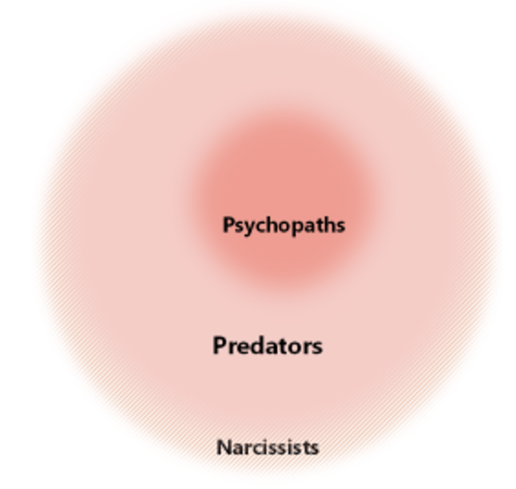
There are hundreds of possible indicators that could be used to identify narcissists, predators, and psychopaths, but through a combination of experience and research, I have settled on three characteristics for each to indicate a threat level. But there also are two other reasons I picked these.
First, the negative characteristics selected are the generic core qualities used in Robert Hare’s Psychopathy Checklist-Revised (PCL-R) as a clinical instrument used to identify a person’s level of psychopathy.
A large body of research validates each quality. Second, the positive characteristics are drawn from the virtues that philosophers for millennia have identified as those necessary for most citizens to possess if any civilization is to thrive.
These virtues are also identified in the bible as vital both for Jews and Christians to develop. Pairing the negative quality with its opposing virtue provides an additional check on the character assessment of any person.
You can’t have dominance on both sides of the same continuum. This is the guide that we developed:
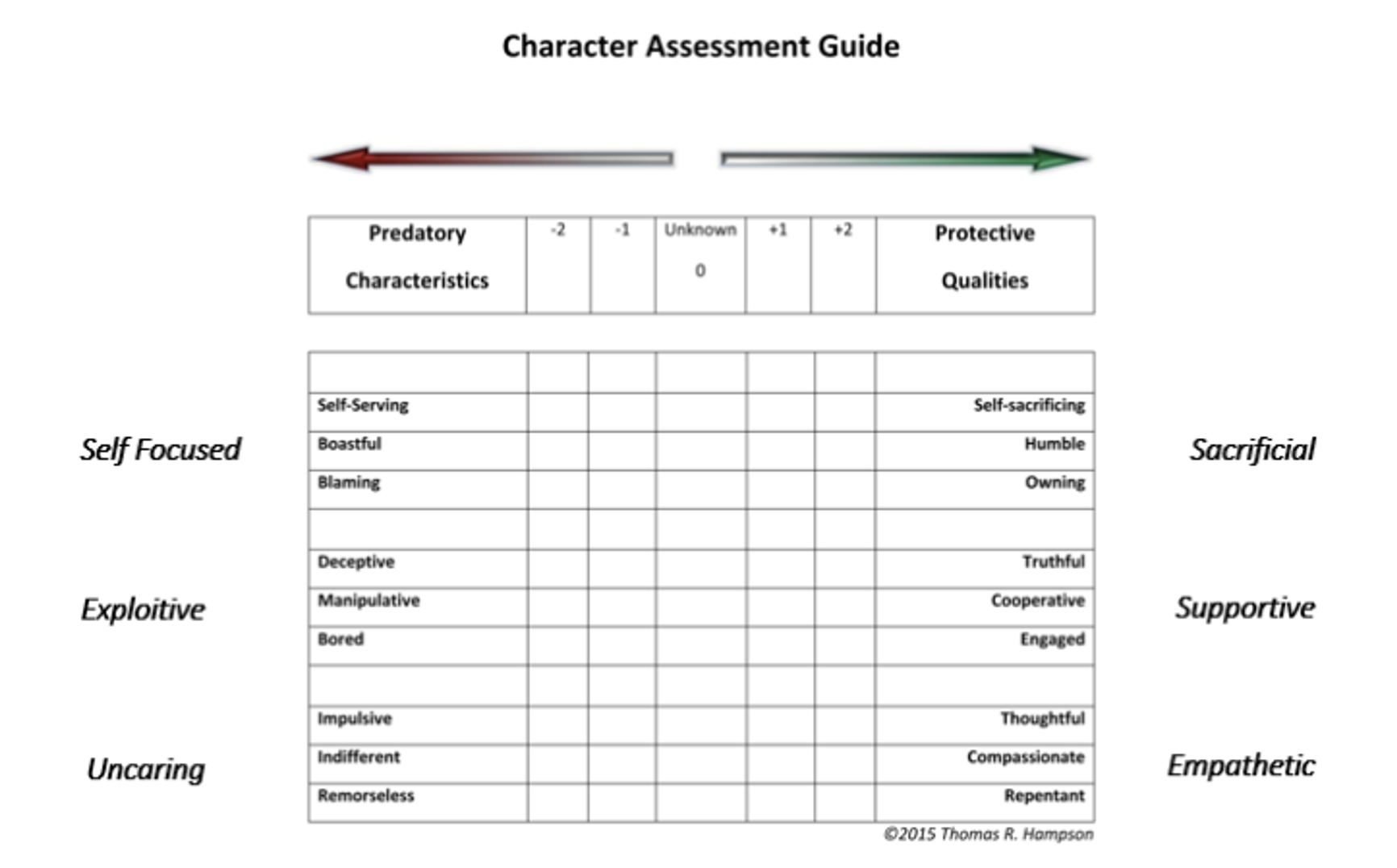
You cannot be both self-serving and self-sacrificing, boastful and humble, deceptive and truthful, and so on. While a self-sacrificing person can be self-serving at times, what we are looking for is dominance on one side or the other. The same reasoning applies to each of the other dimensions. It’s also important to keep in mind that we are not using this model to arrive at a definitive diagnosis of a person’s character. Instead we are looking for disqualifying red flags.
We need to change our attitude about who gets to work with children. It is not a right to be exercised at will. It is a privilege to be granted by those who are in a position of responsibility to protect them. If an applicant to volunteer or join a staff in an organization where children are served, it is up to the applicant to demonstrate he is worthy to do so. Academic credentials or the absence of a criminal record are not nearly enough.
We’ve lost sight of the purpose of background investigations. Qualifying people, especially those who work with the vulnerable, has much more to do with their character than it does with whether or not they have been caught and convicted for some crime. We must use screening methods that are in the best interest of the children, not methods that are in the best interest of those who want to work with children.
When used properly, this model that I recommend will successfully screen out most, if not all, people who pose a threat to children. Moreover, it will weed out those who might be trying to exploit vulnerable adults in our organizations as well. And it will do so in a way that won’t cost a fortune in money or time. Nor will you have many false positives or false negatives. Moreover, any average person can perform the evaluation. It does not take an expert. The principles are simple and easy to apply with minimal training.
The Self-Focused (Narcissists)
Narcissism is the defining characteristic of the predator. Narcissists are focused on themselves, on what they want and how to get it—whether it’s attention, money, sexual gratification, or power. They are self-absorbed and have a grandiose sense of their worth, their skills, and their value in relationship to others. Everyone else is a prop, a mark, someone to be used for their benefit. Narcissism is the engine that powers predators.
This is one of the easier negative qualities to identify. One drawback is that this characteristic applies to many of us. We are born self-centered, but through childhood socialization, we learn to be self-sacrificing for the good of the community and, ultimately, for our own good. But the fact is, all of us continue to be self-centered from time to time.
Nevertheless, there is a big difference between being self-centered sometimes and being a narcissist.
Although narcissism has many facets, I’ve selected three key indicators—self-serving, boastful, and blaming—that represent this larger category. These qualities are not hard to see. The problem is that we have become so accustomed to seeing them we’ve become too comfortable, too accepting of these negative qualities. In fact, many people strive to embrace these traits, emulating their idols in sports, entertainment, media, politics, and other celebrities. It’s hard to find a prominent politician or entertainment professional today who doesn’t exhibit narcissistic qualities.
The check on our distorted view of these character qualities is to look at the virtuous side of the equation—self-sacrificing, humble, and owning. Is the person more giving than taking? Do they consistently exhibit humility, and do they own their mistakes and accept responsibility for their actions? These are solid qualities but lack the flamboyant, self-aggrandizing style of the narcissists.
The Exploiter (Predators)
The key characteristics I’ve selected as red flags for a full-blown predator are deceptive, manipulative and bored (or proneness to boredom). These are much more difficult to identify than narcissistic characteristics because they can be subtle. Deception is sometimes hard to detect. On the other hand, predators very often lie just for the fun of it. This quality makes their deception a little easier to detect, but not much. One way to screen these people out is for every organization to take the position that material misrepresentations or omissions on any application should automatically disqualify the person. You can’t trust a liar even if he’s not a predator.
Manipulators are even less trustworthy. Manipulation always involves deception as well, either deception about the person’s motives or integrity or intentions. Discerning a manipulative person requires strong common sense. Manipulators try to make you believe that what they are proposing will be good for you and that it is in your best interest.
But it’s really only about what they want, what’s good for them, what’s in their interest. Sometimes the goal of their manipulation is only to make you look foolish, to embarrass you. Your humiliation is their reward. Often their manipulation is intended to rob you of your money, time, expertise, contacts, or your virtue—all for their benefit exclusively. They just cast the illusion that it’s to your benefit as well.
Proneness to boredom is a key characteristic of a predator. We all tend to get bored at times. Boring routines are central to most jobs. Most of us tolerate those routines, recognizing that they are necessary to complete most tasks. Adhering to these kinds of routines are intolerable to predators. They seek constant excitement, stimulation, action. On the opposite side of the continuum are those who engage in the full range of duties. These are the people whose commitment to the mission is manifested by responsibly carrying out all the job tasks, routine or not.
The Uncaring (Psychopaths)
Psychopaths not only have no empathy. They have no conscience. They are unique creatures who are totally irredeemable. Psychopaths constitute 1 to 2 percent of the population but comprise about 16% of the male prison population in the U.S. Because they have no conscience, they have no qualms about breaking the law. But most of them never get caught.
It is the psychopath who is responsible for 95% of the cases of child sexual abuse. On average, these serial child molesters abuse 150 children during their lifetime.
Of course, not all psychopaths are child molesters. Most aren’t. Many don’t even break the law, although they push the limits as far as they can go. Nevertheless, we don’t want any of them in our organization, child molester or not, lawbreaker or not. They are dangerous and destructive to any organization.
Psychopaths are the hardest to detect. Many are charismatic and often very likable. While they have no genuine emotions, they are experts at mimicking emotions, whatever the situation. They also have an uncanny ability to read people and to “become” what you most want in a relationship. They make themselves so attractive to you that you can’t consider the possibility that they have character qualities that are red flags. It’s as though they can switch off your reasoning ability.
We have all experienced people like this or know people who have. The primary indicators of a psychopath are impulsive, indifferent, and remorseless.
Many of us do impulsive things—impulsively buy new clothes or a new fishing rod, head to your favorite restaurant, change your hairstyle or cut off your beard or grow a beard. There are an infinite number of things that we do impulsively.
The impulsive behavior of psychopaths rises to a different level. Psychopaths will move across the country on a whim, or drop a girlfriend or change jobs or make a large purchase or make some huge life-changing decision with little or no thought.
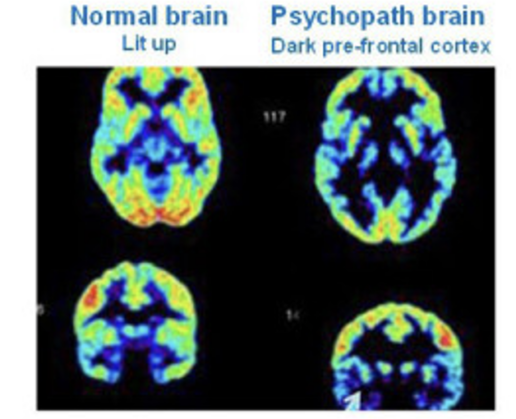
They are indifferent to harm that befalls other people, whether they are responsible for it or not. Usually they will mimic the emotions that the situation calls for if they are in a position where others are observing their reactions. If they think no one is looking, they will display no emotion whatsoever. They don’t have any.
Functional MRI scans have clearly shown this lack of emotion.
Because they don’t have normal feelings in any given situation, you sometimes can detect something a little off in their reaction. There might be a slight delay, or the intensity is off, or they can switch from sad to happy too quickly. Often you experience this incongruence at a gut level.
The better an actor the psychopath is, the harder it is to detect their fake emotions. Nevertheless, the mask of all psychopaths slips from time to time. Don’t dismiss those occasions as “out of character.” In fact, what you see on those occasions is their character.
The only kind of remorse that a psychopath experiences is remorse over a lost opportunity or remorse for getting caught. They have no remorse whatsoever for breaking the law, hurting someone, abusing a child or even killing another human being. They are completely without conscience.
Any emotion that conveys otherwise is a testament to their ability to act. Don’t be confused or fooled by their insincere expressions of regret or apology.
People who are narcissistic or even predatory have the ability to change. This is not the case with psychopaths. They don’t change. While it’s theoretically possible for God to change anyone, I have never seen or heard of a psychopath becoming virtuous.
Not All Predators Are Child Molesters, But All Child Molesters are Predators
If an organization screens out all predators (narcissists, predators and psychopaths), they will get rid of all the child molesters. The more people you train how to recognize a predator, the more effective you will be in keeping them away from vulnerable members of your organization.
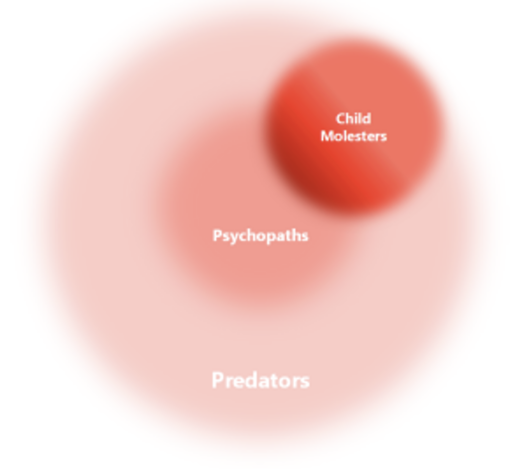
Unfortunately, some are going to get through, and some are already involved in your organization. It requires constant vigilance and evaluation to identify and remove them.
Too often, screening programs operate as though screening is a discrete event. There is an initial screening and periodic re-screening events. Between these events, everyone is focused on carrying out the mission in accordance with the policies. Supervision is task and policy-focused.
This is the wrong approach.
What is required is continuing observation of the staff and volunteers to gain deeper insight into their character. You can never be certain that you haven’t missed something since predators actively mask their negative qualities. We need to get to know each other in depth. That is a continuing process. Knowing someone involves both our emotions and our intellect. And you need to know specifically what to look for.
Our character assessment guide helps to focus your observations.
Grooming and Behavioral Indicators
While character is the best, most reliable indicator, behaviors also wave red flags that we need to recognize. Behavioral indicators are the only way we can recognize if someone is a likely child sexual predator. This is visually represented in the chart to the right. Unfortunately, by the time we see any of those red flags the predator has already had access to the children we are trying to protect.

Let’s start with grooming. Grooming is another word for seducing. Most predators try to seduce or groom their potential victims. Con men, short for confidence men, try to gain your confidence by seducing you into trusting them. Bernie Madoff is a classic example of a psychopathic confidence man. He conned billions from trusting people and organizations.
He did it by building relationships based on convincing people that he was an investment genius who could grow your investment better than others. Of course, that was a lie.
Jerry Sandusky, a notorious child sexual predator, provides an example of predatory grooming. Sandusky groomed governments and institutions in addition to donors and children. His Second Mile organization was identified by George H.W. Bush as one of the points of light in his famous “1000 points of light” speech accepting the nomination for President at the 1988 Republican National Convention.
He groomed his employer, Penn state, and his boss, Joe Paterno, to endorse his efforts. Of course, he also groomed some of the children he was supposed to be serving into a sexual relationship.
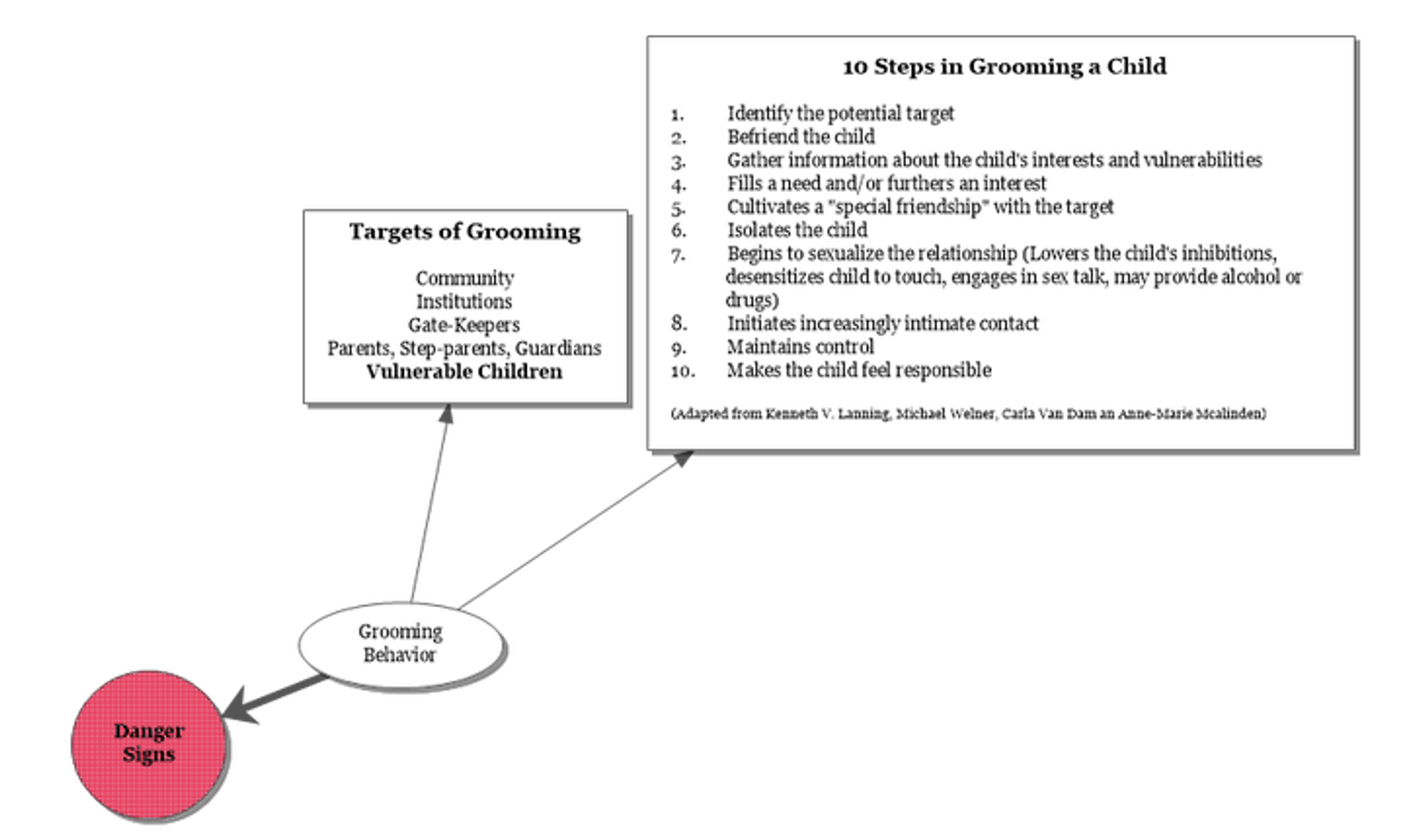
Every adult should constantly be aware of possible grooming activities of predators, especially grooming activities directed toward children. The chart above shows the generic steps of grooming a child into a sexual relationship. In most cases, you won’t see these steps. The experienced predators will use your organization to establish an innocuous relationship with a child and carry on most of the grooming activities off the premises and out of view. That is one reason why it is important to try to screen them out before they ever get an opportunity to build a relationship with them.
Parents and guardians especially need to be sensitive to grooming activities. Parents are targets of the predators’ grooming efforts. Oftentimes single mothers are targeted by predators to gain access to their children. Coaches, teachers, pastors, scout leaders, all might try to gain the trust of parents in hopes of opening an unobstructed pathway to their children. All of us need to be aware of the signs and fully educated on this topic.
Predators target the most vulnerable children and can quickly identify them. Because of this, adults need to be able to see children the way a predator sees them.
Among the most vulnerable children are those who have already been sexually abused. Every person in the organization should know the signs that abused children exhibit, not only to be able to put extra layers of protection around them, but also to create opportunities to help them—that is, to help stop the abuse and to initiate therapeutic intervention. The following are the major signs of abuse for different age groups.
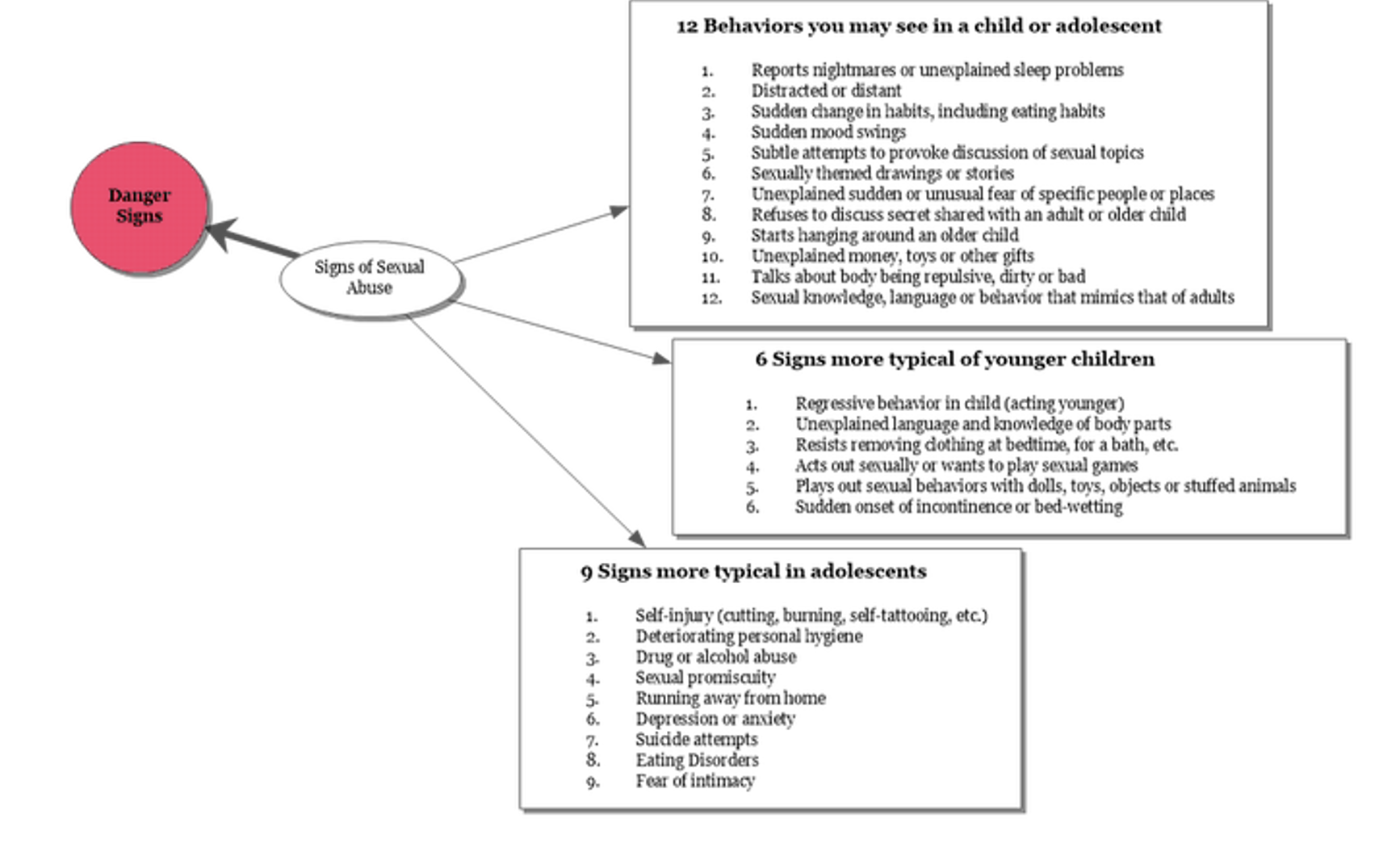
Many of these are behaviors that could be due to some other kind of trauma. In any case, every person who works with children needs to be aware of them, look for them, and know what to do when they see them.
Children at risk for abuse and exploitation fall into two general groups—environmental risk factors or relational risk factors. The chart below lists the major self-explanatory examples in both categories. Again, staff and volunteers need to be aware of these so that they may provide extra protection and attention to these children.

Adults also should be wary of those who pay special attention to children who are at risk, or who exhibit signs of abuse. They are magnets for predators so we all need to take note of who gives them special attention, adult or another child. Those who do, should be given extra scrutiny.
Whenever adults and children are together or when you are observing children play with each other, be aware of their interactions. The behavior during such interactions can provide insight into whether or not there might be a problem. Below are two lists of behaviors to watch for. Instead of allowing yourself to become lost in your own activities, maintain a situational awareness, remain alert. The opportunities to intervene most often are fleeting. You should also note that children provide a substantial risk to other children.
At least 35% of victims are abused by other children, a figure we believe is increasing. Additionally, psychopathic child molesters all start their predatory activity as children. The behavioral indicators below are huge danger signs.
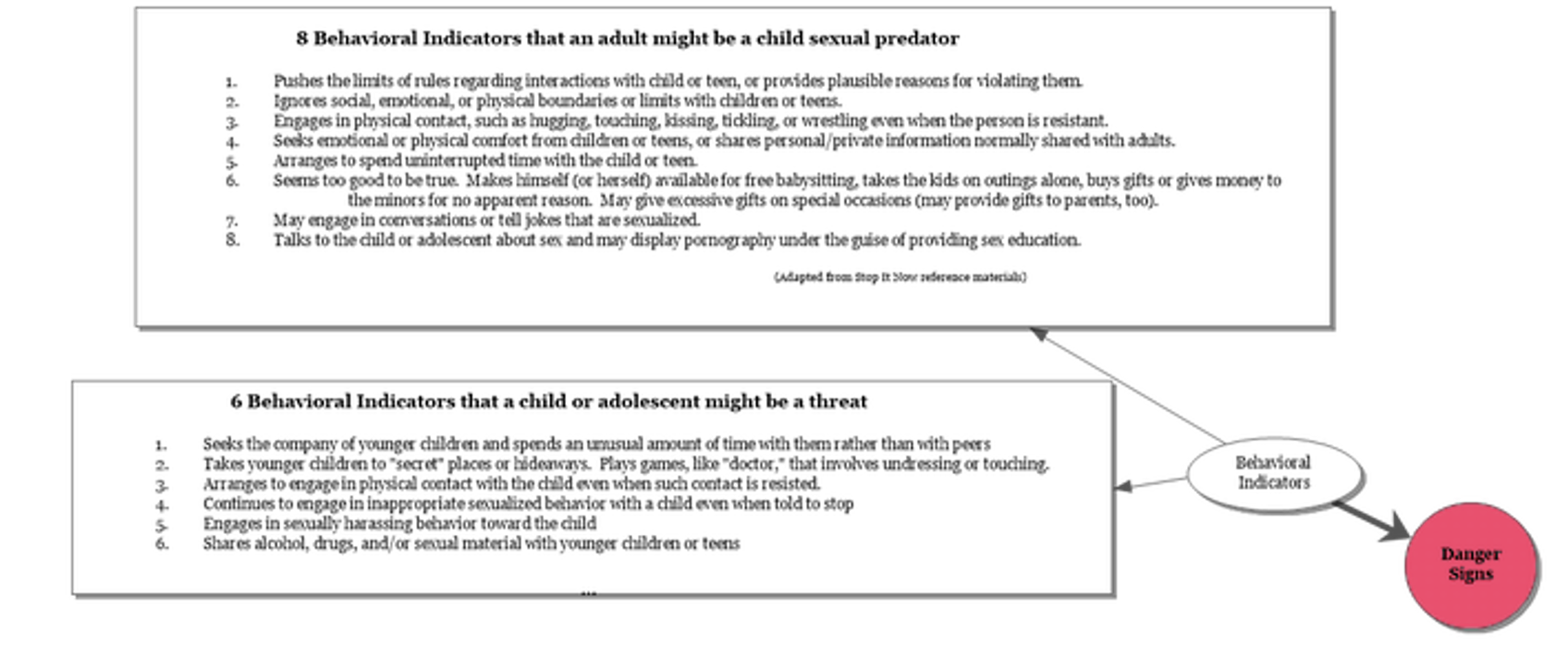
Talking to a person about inappropriate actions is not necessarily going to stop them. Instead it will cause them to become more covert. When you see suspicious interactions, make a concerted effort to see if there are other red flags from other areas. In particular look for predatory character issues, and review the other lists for grooming behaviors, risk factors in the children, etc.
One other list is good to keep in mind when trying to determine if someone might be a predator. This is a list that was developed by Dr. Carla Van Dam. Dr. Van Dam has observed that child molesters tend to come off as “too much” of everything. Below is the list that she came up with.

The last one “too good to be true” is a common characteristic of predators. They try to make themselves indispensable to the organization they are involved with, to the parents of children who are their targets, to the child they are grooming.
They often seek to be deeply loved and appreciated by their marks. Adults who were sexually abused as children often express conflicting emotions about the predator.
On the one hand they loved him. Most of the relationship was positive, they recall. But the sexual abuse is often remembered as troubling. Sometimes the whole relationship is remembered fondly. The confusion and pain entered when the relationship ended and they were abandoned by the predator. The relationship was wonderful and it was terrible.
To a child this is incredibly confusing, and it often is no less so when the child becomes an adult.
Children cannot protect themselves from these evil creatures. You must be their protector and you can only do so if you stay vigilant.
These elements we have been discussing—character qualities, behavioral indicators, risk factors—combine into a comprehensive screening tool that anyone can use, and that every adult should use to protect our children. Here’s what it looks like when you put all the pieces together:
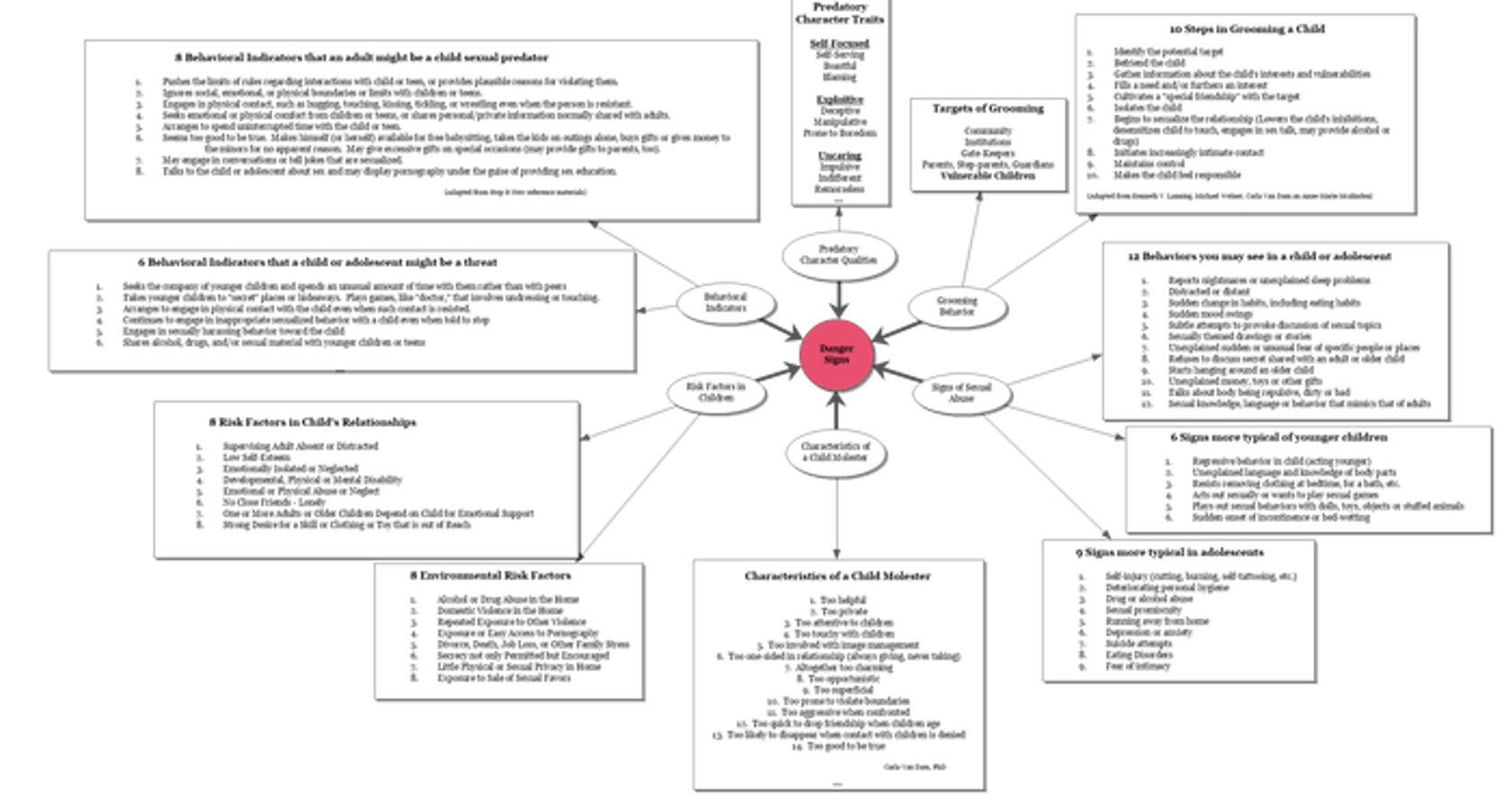
There are many elements to this, many red flags to watch out for. However, it is the character of the people that is most important. We need to take the time and make the effort to get to know the people who are engaging with our children, whether it is another child or an adult.
By doing so we can easily determine if they can be trusted. Remember not to be fooled by likeability. Protecting children requires discipline to look at these qualities, characteristics and behaviors outlined above. No one can do this for you and you can’t pass off the responsibility to someone else. Unless all of us are looking for these indicators, we could miss spotting the danger signs.
There is a natural tendency for many of us to give people the benefit of the doubt, especially if we like the person. We also are concerned about finding fault with someone, judging someone unfavorably. We are all sinners, so who am I to look for someone else’s flaws?
In virtually every case I’ve investigated or read about where a predator has been caught, one or more people have come forward to say they had a feeling there was something wrong with the person, but they had difficultly explaining what they thought was wrong or who to talk to about it. This chart will help you specifically identify what might be causing that gut feeling. Not always, though.
In addition to your own evaluation, it is important for every organization to have a team of people to whom you can report any concerns you might have. That team could be the threat assessment team for the organization, or a special group that is set up specifically to address child protection issues.
In any case, people must feel safe to report even vague suspicions. These are indicators, not hard evidence. It may require developing more information by interviewing the person, monitoring them more closely, or taking some other action. It often takes a group of people, people who are experts or at least knowledgeable on predatory behavior, to discuss the indicators and figure out exactly what they are seeing.
If our recommended program is fully implemented and most adults are trained, there will be a dramatic improvement in screening out those who threaten our children. What is needed is not so much a children protection program, but a child protection culture. It is that protective culture that will secure the safety of our future generations.





















